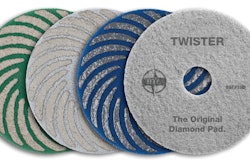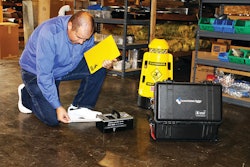
Even though a polished concrete floor glimmers after the final steps of the polishing process are complete, it is not indicative of a zero-maintenance policy. In fact, it is imperative that for a floor to remain polished there must be a plan in place to preserve and hold the finish. It is easy to forget or be unaware of the recurring steps needed to maintain a polished floor, but becoming familiar will ensure you know how a floor retains its long-lasting shine. And in order to accomplish this, there are two types of equipment crucial in protecting and maintaining polished surfaces: the floor burnisher and floor scrubber.
Protect: Floor burnishers
Floor burnishers aim to protect polished concrete by working in conjunction with stain protectors and guards. Stain protectors and guard products offer temporary resistance to spills, and then going over the surface with a burnisher activates these applications and creates a shield against additional spills. Keep in mind though, this is not a fail-proof method. If acidic, caustic or citric liquids spill, they could etch the floor.
A burnisher is much different than a polisher because it spins at a higher rpm, thus generating enough heat to activate the guard and protection products in conjunction with a diamond impregnated pad. Burnishers can run on propane or electricity. In addition, there are many customizable options: dust control, catalytic converter, centrifugal clutch, etc. We recommend a dust control feature because when burnishing at such a high rpm you could stir up dust. Which brings up an important point: clean the floor before burnishing because anything caught underneath can potentially create scratches, which imply unwarranted repairs.
Since guards and protectors are wearable products, depending on the type of traffic, they will need to be reapplied over time. For this protection step, it is recommended that in low-traffic areas you use a scrubber on the floor once a year, up to two times per year for a medium traffic area and at least twice (most likely quite a bit more) for areas with high foot traffic.
Maintain: Floor scrubbers
After adequately protecting the floor, the next step is to actually maintain it, meaning frequent attention. A way of looking at this step is that you are protecting your customer's investment, so minimal effort is well worth the benefit of a polished floor they will be happy with for years to come.
A floor scrubber does just as the name suggests — it scrubs dirt and grime that accumulates on surfaces over time. It is important that for scrubbing you use a soft bristled brush or a soft pad; a more aggressive pad or brush could diminish the polish. A lot of times, using water with a pad will suffice. If you use a cleaner though, make sure it is pH neutral and non-acidic, non-caustic and non-citric. We recommend you sweep the floor and rid it of anything that would otherwise be picked up by the vacuum of the squeegee; not doing so can be hard on the scrubber.
Depending on size of the area, there are walk-behind and ride-on scrubber units. Pad-driven scrubbers are best for polished floors as opposed to a cylindrical drum brush, the reason being that scrubbers with drums generally have stiff brushes, which may wear down the shine of the floor more quickly. One way to combat shine from diminishing is to use diamond impregnated pads on the scrubber. In addition, rejuvenating cleaners that include stain protection aid in this. And lastly, diamond discs fit easily under a scrubber and brighten up a surface that has lost its image transfer.
This step demonstrates how creating a maintenance schedule is an efficient way to handle how often you scrub polished concrete floors. And again, the amount of traffic really dictates this. Low traffic areas can manage with only one to two times per month, medium traffic areas should be maintained three to four times per month and high traffic areas need maintenance one to two times per week.
Both the protecting and maintaining steps explain why people choose polished concrete. Namely, it is low maintenance, not very labor intensive and involves maintenance that can be accomplished at night to avoid completely shutting down an area. Develop a maintenance schedule with the right equipment and trust me, you’ll be incredibly happy you did.
About the Author
Heidi Hudnall is the marketing coordinator at Runyon Surface Prep Rental & Supply. She specializes in all things internet marketing, with an emphasis on content creation, website maintenance, blogging, social media and email marketing. Although she is relatively new to the industry, through research and hands-on exposure she has learned much in just the past few months.



















